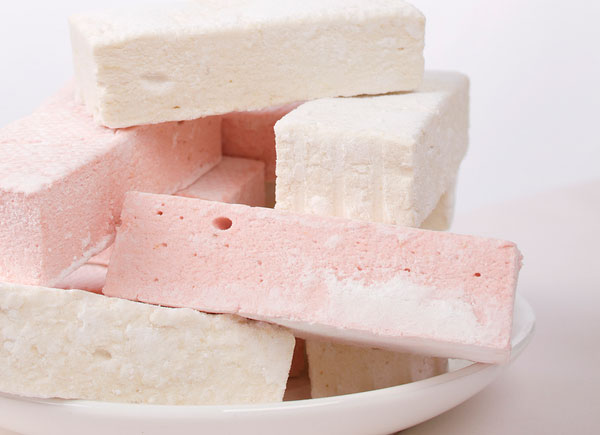Fluffy Rose & Rhubarb Honey-Sweetened Marshmallows
This post may contain affiliate links, including those from Amazon.com, which means we earn a small commission off your purchases. And here's the thing: We only mention services and products that we think are truly worth your attention, whether they're free, paid, or otherwise. This site relies on YOUR trust, so if we don't stand behind a product 110%, it's not mentioned. Period.
Rose & Rhubarb Honey Guimauve
Okay, okay… so calling marshmallows as we know them by their original French name – guimauve – might be stretching it a bit. “Confection” is probably more accurate, as guimauve were originally sold in France only in confectionery shops, and honestly, enjoying them as a confection is my favorite way to eat them. However, with the notable exception of toasting marshmallows over a campfire, marshmallows just beg to accompany some other delectable treat – hot chocolate for example.
The rhubarb in this recipe makes for a wonderful twist on the classic. I love the earthy tones complimenting the sweet melty-ness of the honey and sugar. If the color is not deep enough for you, add in a few drops of pure beet, plum, or cherry juice.
And for those of you wondering about the sugar in this recipe – while it is possible to make these using solely honey, I have kept quite a bit of the granulated cane sugar in the recipe merely because the honey-only varieties have the infuriating habit of suddenly melting when heated. This is lovely if they're in something (like hot chocolate), but not so lovely if they're over a campfire. Since these are a treat to be eaten only very occasionally, I have few qualms about indulging in a little bit of cane sugar now and then. If this is an issue for you, feel free to substitute coconut sugar in its place or make them entirely with honey.
Rhubarb Marshmallows
2 tablespoons unflavored gelatin (I use this one)
1 cup rhubarb juice (approx. 8-9 stems – see below) – reduce to 1/2 cup
1 ½ cup evaporated cane juice
2/3 cup honey
1/3 cup water
¼ teaspoon sea salt
¼ teaspoon rosewater (optional)
cornstarch or tapioca starch for dusting
makes 1 8×8 pan
Obtain about 1 cup rhubarb juice, either by juicing the rhubarb stalks in a juicer or by chopping the stalks into 1-inch pieces, then pureeing them in a blender with just as much water as it takes to get the pieces to blend, then squeezing the puree in two layers of cheesecloth.
Place the rhubarb juice in a medium saucepan. Bring to a boil, then simmer over medium-low heat until the juice is reduced to 1/2 cup, about 30-40 minutes. Skim off any foam that rises to the surface.
Remove from the heat and let cool completely.
While the rhubarb concentrate is cooling, prepare your tools. Fit an electric mixer with the whisk attachment and grease the whisk with a bit of butter. Grease 1 large spoon or spatula. Line your pan with plastic wrap. (Yes, this is one of those rare instances when plastic wrap in all its disposable glory is an excellent tool. If you're concerned with BPA or PVC exposure, use a more conscientiously manufactured brand, such as this one.) Grease the plastic wrap with a sheer of butter as well.
Place the cool rhubarb juice in the workbowl of an electric mixer. Sprinkle the gelatin over and let it sit until the gelatin has softened, about 5 minutes.
Meanwhile, combine the cane crystals, honey, water, and salt in a saucepan that pours easily. Heat over medium-high heat until it boils, then continue to boil the mixture until it reaches soft-ball stage, about 234-240 degrees Fahrenheit.
Just as the sugar and honey syrup comes to temperature, add the rosewater to the rhubarb juice and gelatin and starting whipping it on high speed. Very slowly pour the syrup into the rhubarb juice, being careful not to splash. Letting the mixture slide down the side of the bowl can be a good way to do this without spilling if your saucepan or mixer won't let you drizzle efficiently.
Continue whisking on high speed until the concoction is very fluffy and stiff, about 7-10 minutes.
Scoop the sticky, goopy mixture into your prepared pan using the greased spatula. Press it into all the corners and smooth the top as much as you can, then let the pan sit uncovered at room temperature for 12-24 hours.
When you're ready to unmold the guimauve, dust the top liberally with your powdered starch. Lift the plastic wrap out of the pan and peel away the sides as much as possible, dusting any sticky surface as you go. Place a cutting board on top, then flip the confection over and pull off the plastic wrap entirely, dusting the surface again with starch.
Grease a large knife or a decorative cookie cutter and cut into squares or shapes. As marshmallows are exposed, dust them with starch and shake the excess off.
Guimauve will keep for several weeks at room temperature if stored in an airtight container.
This recipe is easily doubled.






Delightful! I make my own too, but I never thought of using rhubarb!
We have it coming out of our ears in our garden (yay! this is not a problem in my book!) so I like to put it in as many foods as possible. Thus, rhubarb marshmallows. 🙂
I hope you enjoy them!
Sounds really yummy! I’ll have to try it out. Thanks!
Lynn
Oh no….. But where is the marshmallow root? It isn’t listed. That actually makes real marshmallows that are even good for gut issues….
I totally agree – but it’s a completely different formulation and marshmallow root can be difficult to find, so for this particular recipe, I went with the more traditional French confectionary version. 🙂 I do love marshmallow root marshmallows, though!
The recipe calls for “1 ½ cup evaporated cane juice’…do you mean ‘1 ½ cup evaporated cane juice SUGAR’ instead? I just want to make sure I get the right ingredients before making this! I am very excited to try it :).
Yes – the sugar has many names, one of which is “evaporated cane juice,” as the juice of the sugar cane is what goes through the evaporation process, leaving behind lots of little crystals.
So, yes, any minimally-refined sugar will do for these yummy treats! Enjoy!